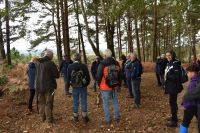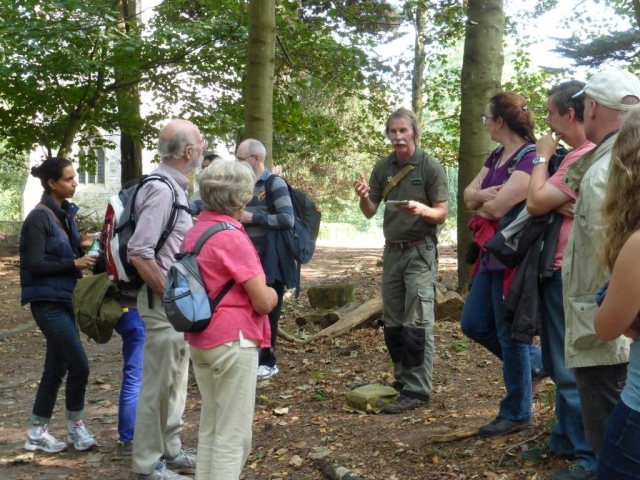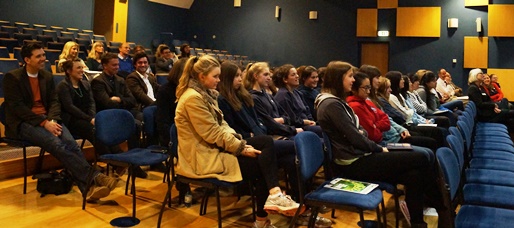Reports
Visit to Arne Nature Reserve
12 October 2024
An impressive morning was had at Arne Nature Reserve, where the BBC Springwatch programme is filmed. We were met by two very informative tour guides who took us along the Coombe Heath Trail over predominantly lowland heathland. Along the way we heard about the management of the area to ensure pine trees don't dominate, instead allowing for open heathland with heather, gorse and small shrubs with pockets of ancient oak woodland combining with areas of mudflats and wetlands of tidal water. Grazing animals, such as sika deer, cattle, ponies and pigs help to maintain these habitats, which encourages biodiversity.
Arne is home to the Dartford warbler. A bird that does not like the cold, wet and windy weather-somewhat typical of the UK. Once nearly extinct following the winter of 1962, subsequent milder winters and conservations efforts have seen this illusive little bird bounce back from just two reported breeding pairs at Arne over 90 years. Sightings have also been spotted further northwards and eastwards within the country - an indication of how a species adapts to climate change. Although we did not see one, we certainly heard its distinctive call - a bit like a metallic rattle!
We were awestruck when we reached the hide overlooking Middlebere Channel. In front of us was a vast array of birds, coming and going like Heathrow airport with formations that would put the Red Arrows to shame! There were oyster catches, curlews, avocets and egrets. On the horizon, a buzzard and osprey were also spotted.
There is much to see and learn at Arne and another visit in the spring is a must.
If you go to the Arne Moors Project website, you will see that a large area of permanent wetlands is being created and will bring with it yet more interesting species.
The project is often interrupted as different forms of wildlife make their nests and the remains of prehistoric and iron age artifacts are uncovered. So it will be a while before this important project is completed.
It is encouraged that projects like those at Arne are happening, producing a wide range of varied habitats in one place that attracts and sustains a huge array of species.
The Wessex branch of the RSB would like to thank the tour guides Anna and Terry for this stimulating and resourceful introduction to the reserve.
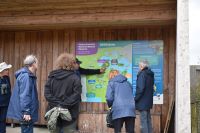
Dr EJM Eversham CBiol FRSB
Science Fair at Purbeck School
16 March 2024
The Science Fair was held on the afternoon of Saturday 16th March 2024. There were many stands covering the corridors and classrooms of the school featuring interactive activities from The Dorset 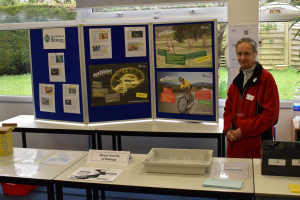 Wildlife Trust, The National Trust, The Etches Collection and many other institutions.
Wildlife Trust, The National Trust, The Etches Collection and many other institutions.
There was a constant stream of visitors throughout the afternoon and both parents are children took part in the hands-on activities at the RSB stand. The theme was 'the senses' and almost everyone was tempted by the 'what can you feel?' activity, tentatively placing their hand in a box to decipher the items. The 'what can you smell?' activity was equally attractive.
Free RSB pencils were dished out to those who answered correctly and the 'I love biology' stickers were snapped up by all. The stand also featured careers in biology and colourful and informative posters about animals and plants and their special senses.
There was certainly a buzz around the stand with invigorating discussions about the world around us amongst the many families and friends visiting.
Dr EJM Eversham CBiol FRSB
Tropical cats in danger - technology to the rescue
23 November 2022
Wildlife monitoring involves encounters with many life-threatening hazards in the forests studied by Professor Patrick Doncaster, Southampton University, and his team. Attacks on humans by big cats are relatively rare, but the deadly Fer de Lance snake is a much greater hazard to scientists working in Central American forests; the snake's cryptic coloration makes them difficult to spot in the undergrowth.
Patrick was addressing those who attended the Wessex branch AGM, talking about the use of modern technology in monitoring big cat populations and human activity. Although satellite technology can now provide detailed information on forest clearance and the impact of fire and tree death, information about what goes on beneath the canopy is not available and so up until now illegal hunting has gone unseen. There are areas where there are human observers on the ground, but this only provides a very localised snapshot of what is happening.
Audio technology now allows gun shots to be identified and recorded. Recorders are often very bulky and expensive making them vulnerable to theft, however the new 'Audio moth' recorder is relatively small and cheap so that accurate information can be gathered from much larger areas.
Camera traps are useful for monitoring big cat populations as well as providing stunning pictures of these beautiful animals. They have traditionally been placed along known walkways, however studies using randomly placed cameras over a selected area of the forest have shown that the walkway studies give precise but not accurate results. In these areas pumas, jaguar, ocelot and others co-exist and, although they all share prey species, DNA analysis of scat shows up differences in preferred prey between species.
Any work of this kind can only be effective if it also involves engagement with local forest communities for whom hunting is a way of life. Local engagement and acknowledgement of their traditional skills and knowledge of the forest is a key part of the work of this team.
Dr Hilary Otter FRSB
AGM & Lecture - Adaptations of Antarctic marine animals and changing environments
5 October 2021
Although it is well known that the vast majority of organisms in the Antarctic occupy marine habitats, it is perhaps easy to forget that this means anyone studying them has to dive beneath the ice in order to do so. Professor Lloyd Peck from British Antarctic survey is no exception. He presented vivid descriptions of diving amongst dense summer blooms of phytoplankton where each individual is so large as to be visible to the naked eye and visibility is limited to 3m. The difficulties of data collecting 365 days a year, the photographs of 1.5m chain saws for cutting through the ice and the enormous sea spiders with 12 legs and giant isopods all added to the drama of his lecture.
The Antarctic marine environment is exceptionally thermostable but only highly specialised species are capable of living at temperatures of around 0 degrees. In spite of the cold, the Antarctic seabed is highly biodiverse. It would be logical to predict that these species have similar rates of growth and development as those elsewhere on the planet once adjusted for temperature. However, gastropod molluscs grow 5-10 times more slowly than predicted because protein synthesis is not only extremely slow but the proteins made are less stable at those temperatures and start to unfold. Proteosomes are responsible for degrading and recycling poorly functioning proteins within cells and proteosome activity in Antarctic fish is much higher than that in related species that live above 5 degrees.
One of the groups most vulnerable to warming are the Icefish, Caenocephalus aceratus which have no red blood cells, haemoglobin or myoglobin. Their extremely low metabolic rate and much larger capillaries means that the 3-5% dissolved oxygen in their blood is sufficient but, as temperatures warm and their metabolism increases, this will no longer be sufficient to sustain life.
Experiments investigating the effect of warming show that Antarctic communities have, at maximum, a 3-4 degrees window of survival during warming experiments. This, combined with their long generation times, production of fewer eggs and slow physiology means that they have fewer opportunities to produce new adaptations and are very vulnerable to the effects of climate change.
Dr Hilary Otter FRSB
Biologize your development; an online lecture
20 May 2021
Dr Phil Richardson FRSB, member of the RSB Wessex committee and an NHS director, offered his audience a new approach to personal development based on biomimetics. He argued that 3.8 billion years of natural selection has resulted in the many examples of extreme adaptability and economy seen in the natural world today including sparing use of local resources, efficient gathering and use of energy, using waste as a resource and cleaning up afterwards. All of this enables organisms to remain in balance with the biosphere and is supported by the ability of organisms to diversify and cooperate and is all underpinned by information gathering.
Phil has used these principles to solve specific challenges when working with different industries. The development of a self-cleaning paint was based on the rough surface of the leaves of Alchemilla mollis. Aqua jelly robots (Festo) are artificial autonomous jellyfish-like machines with a translucent body and ‘tentacles’ for propulsion and can be used to check and repair deep sea cables. Packaging holding sachets of Whiskas cat food was reduced using a model based on the mechanism used to hold and release spores from the underside of a fern fronds. Biomimetics can also be used to look at interpersonal relationships using a symbiosis matrix which can highlight when a relationship has ceased to be of benefit to both parties.
Phil then introduced the idea that crab ecdysis can be used as a model for personal development and growth. This carefully ordered and controlled process involves recycling of materials, casting off the old shell, expansion and manufacture and development of new material. These principles can all be applied when evaluating ones’ current strengths and deciding which new skills may need to be learnt and which existing skills can be taken forward, further developed or even left behind as they would not be needed for a future role.
Dr Hilary Otter FRSB
The evolution of mammals; what teeth tell us about our earliest ancestors
22 March 2021
It is extraordinary how much can be learnt from tiny fossil fragments! Dr Neil Gosling’s talk for the Wessex branch focused on discoveries from very small pieces of the jaw bones of two very early mammals from the late Triassic, 270 mya.
Keuhneotherium and Morganucodon were shrew-like insectivores with typical heterodont dentition. Although it was previously accepted that these earliest mammals were dietary generalists, Neil and his team found this not to be the case. The early mammals had to eat constantly to support their high metabolic rate and as chewing different foods causes differential abrasion on tooth surfaces, it was possible to scan the teeth to assess what stresses they had been subjected to. Data from the teeth of modern bat species with different diets were used for reference and this clearly demonstrated that these two insectivores were early adapters and dietary specialists.
Further investigations based on knowledge gained from research into walrus teeth meant that both the age and the sex of these two extinct species could be confidently established by using a variety of techniques to count the number of annuli (growth rings) in the cementum layer which anchors teeth into the jaw.
Interestingly this showed that the lifespan of these mammals was far longer than would be expected for an equivalent sized modern mammal but a little less long than that of an equivalent reptile. In addition, the cementum count also allows an estimation of metabolic rate. Modern mammals of equivalent size have a very high BMR owing to their enhanced thermoregulatory control whereas in Keuhneotherium and Morganucodon the BMR was considerably lower, as would also be expected in a modern reptile.
Finally, estimation of blood flow through fossil femur fragments of Morganucodon suggested that the maximum metabolic rate of these early insectivores also places them between reptiles and modern mammals. All this points to the surprising and satisfactory suggestion that these early stem mammals are, in fact, intermediates between reptiles and mammals.
The scope of this talk, the variety of techniques used to establish the facts and Neil Gostling’s informal and approachable manner gave rise to a high number of questions from the large online audience.
Dr Hilary Otter FRSB
AGM & Lecture - Animal Behaviour: From zombie cockroaches to elephants scared of bees
Thursday 3 December 2020
An attention-grabbing title featuring a popular area of biology meant that this online event attracted a large audience. Evolutionary biologist and award-winning author Dr Tristram Wyatt began by arguing that smell is a key to behaviour across the animal kingdom. He introduced us to bioassays used in early experiments into pheromones. A positive result was recorded by eliciting a relevant behaviour such as mating rituals in male moths. We saw images of the extravagant and elegant antennae of male moths which evolved to resemble molecular sieves because of this strong selection pressure.
He next considered how the study of animal behaviour has changed over the centuries, starting with the earliest images of cave paintings. He discussed the dangers of the anthropomorphism seen in much writing down the centuries and the fact that Darwin was the exception to this. The many lab-based experiments carried out by comparative physiologists such as Skinner are problematic; despite rigorous experimental design, the behaviours seen were entirely divorced from natural behaviours in the wild.
The survival value of a specific behaviours in the wild is critical to modern understanding. Tinbergen noted that black headed gulls always remove eggshell from their nests as the bright white interior acted as a beacon to predators. Recent studies into the evolution of new behaviours have found that a cricket population in Hawaii no longer sing as a parasitic fly, attracted by their song lays its eggs so that its maggots feed on the cricket and only the mutant non-singing individuals survive. The ‘zombie’ cockroach is just that because the parasitoid jewel wasp injects a combination of neurotoxins including dopamine into precise locations in the brain. Starling murmuration relies on each bird keeping a set distance from its seven closest neighbours and thus reduces risk from predators.
Studying animal behaviour can lead to positive change. Marian Dawkins investigated animal welfare by studying behaviour under different conditions. This led to legislative changes in the way in which caged hens could be kept. Conflict between farmers and roving elephants is reduced by exploiting the elephants fear of bees. Farmers are supported in erecting beehives on their land which deters the elephants.
This fascinating account was followed by many thought provoking questions from the audience. The event can be viewed on the RSB’s YouTube channel.
Dr Hilary Otter FRSB
Responding to the COVID-19 crisis
Wednesday 29 July
It was a warm evening when a crowd of about 50 settled down at their computers to participate in the first Wessex virtual event. Three speakers, who have been highly instrumental in organising the Dorset COVID response, discussed the unique challenges and what they have learnt.
Sam Crowe, Director of Public Health Dorset, talked through the various stages of the epidemic from February to July, emphasising key points such as the developing understanding of how this epidemic differs from seasonal flu and the significance of asymptomatic spread. He discussed the usefulness and problems associated with modelling, the necessary but slow improvements in surveillance and testing, the current situation, and the need for future planning.
Dr Karen Kirkham, a GP who is also involved with National Primary Care planning, focussed on the response of GP services and the rapid adaptations that were needed as the situation unfolded. Within 2 weeks in March, 90% of consultations became remote, e-prescribing was instituted, patients displaying COVID symptoms were isolated, PPE had to be sourced and used and vulnerable patients identified whilst maintaining important routine services. An additional challenge was the reduction in workforce due to quarantining. Positive outcomes included a huge increase in goodwill across services and new partnerships with academia and industry.
Finally, Dr Phil Richardson (Chief System Integration Officer for NHS Dorset CCG and Gold Command) described how the military, voluntary sector and emergency services were brought together to coordinate the wider community response. He discussed the deluge of information that needed to be read and responded to. The Gold Command Incident Centre ran remotely and was responsible for solving diverse problems such as finding engineering solutions that ensured oxygen supplies could be maintained when demand was high. Difficulties were exacerbated when public policy announcements preceded documentation.
Susan North MRSB
Unravelling the double helix
Thursday 10 October
It is perhaps surprising that this Wessex branch Biology Week lecture focusing on the structure of DNA attracted a capacity audience as the stories and individuals immediately surrounding the discovery of the DNA double helix are so well known. However, Professor Gareth Williams chose to pay little attention to the celebrities of the story and to focus instead on lesser known characters, ‘the lost heroes of DNA’ and this meant that this event attracted a diverse and enthusiastic crowd.
Professor Williams (emeritus professor of medicine and dentistry, Bristol University) drew on material from his latest book, Unravelling the Double Helix, reminding us that although Watson and Crick were responsible for finally piecing all the bits of the puzzle together in 1953, research into the materials of heredity had begun over 100 years before this. We were introduced to a wide cast of characters and personalities as well as the scientific and political contexts in which they worked. This included the life and early death of unhappy Friedrich Miescher, first to describe non protein ‘nuclein’ (1868) and, later, the startlingly handsome and cultured Erwin Chargaff, victim of anti-Jewish purges in European labs, whose discovery that there were consistent regularities in the proportions of bases in DNA provided a vital part in the data jigsaw used by Watson and Crick to describe their model for DNA. Chargaff was one of many who were persuaded that genes must be made of nucleic acid rather than the structurally diverse proteins also extracted from the nuclei of eukaryotic cells. With hindsight, it is astonishing to think how long this debate raged for; the case for DNA being the molecule of heredity was still not accepted by all researchers even in the mid-1940s.
Dr Hilary Otter FRSB
An Introduction to Wildlife Monitoring
Friday 23 - Sunday 25 August 2019
A group of members from multiple regions were privileged to attend a wildlife monitoring event at Haseley Manor, a reserve developed over many years by Professor Anthony Roberts OBE FRSB who has created a fantastic habitat for numerous species.
On the first evening, Iain led us out to check some moth light traps. For our first experience on the reserve, Iain’s knowledge and enthusiasm definitely set the bar very high! From the Setaceous Hebrew Character to the Iron Prominent moth, each specimen had something new to teach us. I learnt, for example, that some moth species do not eat at all in their adult lives.
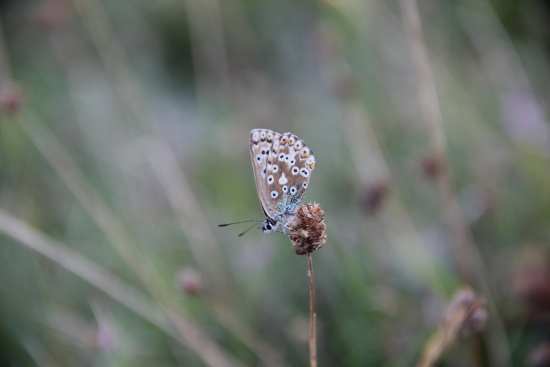
Photo credit: Carine Fixmer
Fiona’s very insightful talk about dormice set us up to do some monitoring. We soon learnt that the dormice ‘don’t read the books’ and use the ‘correct’ boxes, so we checked over 100 dormouse and bird boxes for potential recordings.
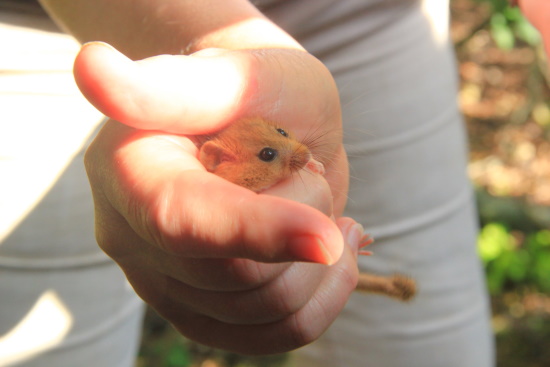
Photo credit: Carine Fixmer
After some butterfly and dragonfly spotting with Jim, our host Anthony gave us a tour of Haseley Manor House and we ate a delicious meal cooked by his wife Vivian. To eat in such a beautiful building, bursting with history and stories was an incredible experience, for which we all felt very honoured.
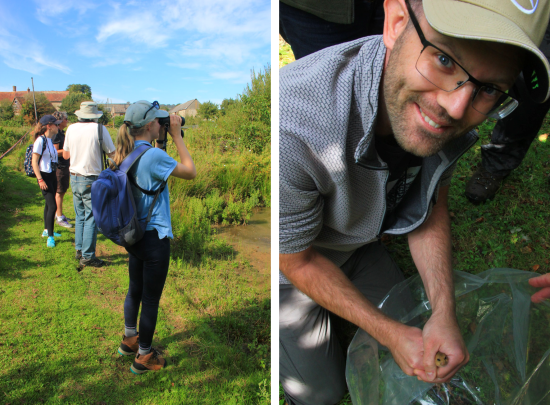
Photo credit: Carine Fixmer
A 5:00 wakeup call the next morning gave rise to some sleepy members, though the reserve at sunrise looked even more spectacular. The bird ringing experience taught us both how and why the birds are monitored and what recordings are taken. Numerous species were caught including Reed and Sedge Warblers. Notes were made of the birds’ age and feathering as well as measuring their weight and of course putting a ring on!
We are all very grateful to our generous and hospitable hosts Anthony and Vivian, as well as all of the experts for giving us such a fabulous weekend on the reserve.
Emma Thornton, BioNet member
Day trip to the Hawk Conservancy Trust
30 July 2019
Fortunately, the dreadful weather forecast predicting high winds and heavy rain did not deter the 25 members, plus friends and families, who turned up to the Hawk Conservancy Trust to enjoy a very full and varied day. A highlight was a talk about the National Bird of Prey Hospital. Here, 200 sick, injured or orphaned birds are treated each year. This was followed by a tour of the treatment rooms, nursing bays and rehabilitation wing.
Everyone enjoyed the flying displays, the most impressive of which involved not just owls, eagles and vultures but also secretary birds and sacred ibis. As well as visiting all the birds and learning the current threats to their continued existence in the wild, some of us also chose to handle a Harris Hawk, providing plenty of photo opportunities!
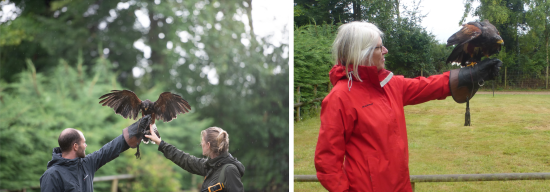
Photo credit (left): Mark Ashton.
Photo credit (right): Jack Coughlan FRSB. Handling a Harris Hawk.
The Trust was formed in 2002 to take responsibility for bird of prey rehabilitation, conservation and research activities. Today, conservation and education work continues on a global scale and so we were particularly fortunate to finish the day with a lecture from Dr Campbell Murn FRSB, head of conservation & research at the Trust.
Campbell’s research specialism is in vulture conservation, vultures being the most threatened group of birds globally, 70% vulture species having poor or very poor conservation status. Campbell focused on the significant decline in African vulture populations due not only to poisoning of elephant carcases by poachers, but also to secondary poisoning (aimed at top predators) by farmers in retaliation for taking livestock. Habitat loss and climate change are also influential factors.
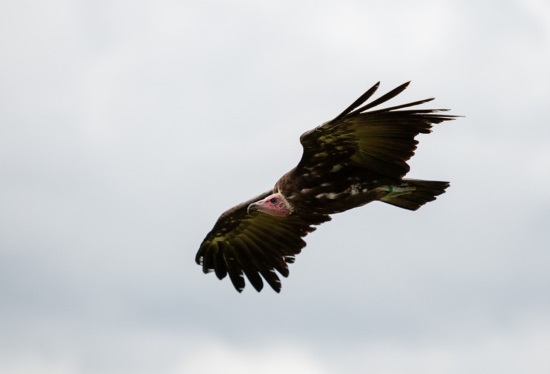
Photo credit: Mark Ashton. Flying vulture.
Many challenges face conservationists working in this field, including funding, equipment provision and the need for accurate data on vulture strongholds, population numbers, genetic profiles and ecosystem health so that effective landscape scale actions can be implemented.
The groups enjoyment of the day was increased by the fact that we had a comfortable room at our disposal. This was particularly welcome for those of us with picnic lunches as it meant we were able to dodge the rain and stay relatively dry throughout the day!
Dr Hilary Otter FRSB
Purbeck School Science Fair
27 April 2019
I represented the Wessex branch at the Purbeck School science fair, advertised as, “Fun, free and a great educational afternoon out for all the family”.
It was indeed. From the moment the doors opened at lunchtime to late afternoon, when a bell rang to indicate it was time to leave. We had a heavy stream of families, young and old, taking part in everything that was on offer.
Every child received an “I love biology” sticker, wearing it with pride on their chests. The young children took great delight in receiving an RSB pencil once they had participated in the activities I had created. Everyone loved placing their hand in boxes trying to determine its contents and learning about their sense of touch and how the brain can get confused when it can’t see the contents - although the young children did try to take a peak!
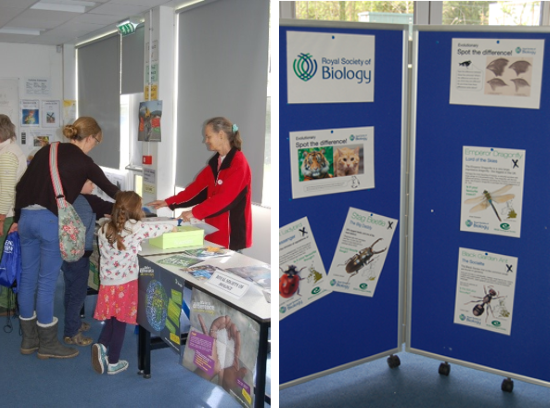
The adults seemed to enjoy the reaction time test, trying to beat one another and their children at catching a ruler quickly. I was most impressed by the attempts, made by the adults, at describing the pathway of a nervous impulse from the stimulus to the effector to their children, although the listeners were not that impressed!
A very successful afternoon and great fun all round.
Dr Elizabeth J M Evesham CBiol FRSB
Gattaca - Are we nearly there yet?
8 March 2019
On 8th March, RSB members gathered for a screening of Gattaca at the Salisbury Arts Centre. This was followed by cake and a fascinating talk by Dr Carl Mayers OBE CBiol FRSB, Defence Science and Technology Laboratory’s lead in forensic genomics. Gattaca is based on a dystopian future where an individual’s genetics determine their career, status and value to society.
The film depicted the prediction of traits from DNA and the diagnosis of an individual’s entire medical history at birth. Dr Mayers explained that this technology does exist, but not at the capacity shown in the film; commercial genetic testing companies such as 23andMe® utilise this technology to predict the likelihood for diseases such as breast cancer and Alzheimer’s, or traits such as eye colour.
DNA editing and testing of embryos was also a major theme in the film as natural births became rare and “designer” babies are the norm. The technology is available today, as in late 2018 the gene editing tool CRISPR/Cas9 was used on human embryos.
Dr Mayers briefly described the ethical implications, which are complex and are being heavily debated as this was done unauthorised.
Gattaca also depicted instant DNA testing to identify individuals. This is not yet possible as testing DNA usually requires a minimum of 90 minutes and will not become instantaneous anytime soon.
Finally, the film showed that genetic privacy no longer existed. There are laws protecting genetic privacy within healthcare testing, however, commercial genetic testing companies hold the genetic profiles of around 26 million people.
This genetic data is not secure, mirroring the accessibility of genetic information in Gattaca. As Dr Mayers outlined, the only current barrier to insurance companies using genetic data in the UK is a voluntary agreement called the “Code on Genetic Testing and Insurance” between HM Government and the Association of British Insurers.
Dr Mayers concludes: the future depicted in Gattaca is possible today in terms of technology. It is important to note that ethics is heavily considered within science and that films like this make us contemplate the future and how best to safeguard it.
Isadora Sinha (Affiliate student)
Lower Sixth Careers Convention, Sherbourne School
23 March 2019
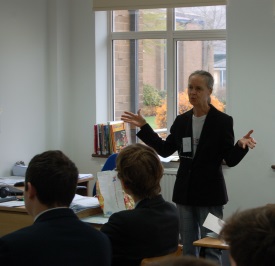 For the fifth year running, I have taken part in a well-organised, busy and thriving careers convention on behalf of the Wessex branch.
For the fifth year running, I have taken part in a well-organised, busy and thriving careers convention on behalf of the Wessex branch.
Despite the early morning start and a long drive along county lanes, I have always looked forward to the event and the welcoming and warm atmosphere of the school. This occasion was no exception.
The classroom was filled with smart and polite boys all eager to find out about various career pathways as well as my own. I was able to offer advice about personal statements, work experience, the numerous opportunities they have in the field of biology and in higher education as well as websites that provide useful information to help them with their university choices. It is always such a pleasure to be able to offer advice and to speak about one’s own experiences to young people embarking on an exciting and fruitful future.
Dr Elizabeth J M Evesham CBiol FRSB
Bombay Sapphire Gin Distillery
28 September 2018
On a glorious unseasonably warm September afternoon, RSB members were treated to a bespoke, horticultural tour of Laverstoke Mill, home to the Bombay Sapphire distillery.
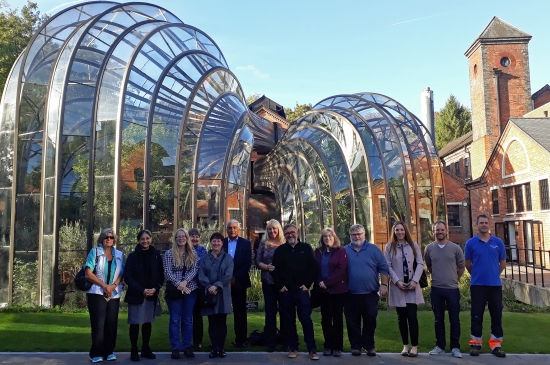
Resident horticulturist, Chris Cotterell, introduced the natural history of the site, which is situated within a Conservation Area and Site of Special Scientific Interest (SSSI) in rural Hampshire. The River Test flows through the entire site creating a unique wetland habitat. The Test is the purest chalk-stream in the UK with many native species inhabiting the river and surrounding wetlands, including Brown trout and Red kites (both of which we can now attest to!).
We learnt about the trials and tribulations of designing, constructing and implementing a modern new horticultural landscape that not only surrounds a successful distillery, but also aims to complement the historical architecture of the former paper mill and conserve the local flora and fauna, including the local bat roosts.
The conscientious nature is clearly extended to an award winning eco-friendly approach to renewable energy too. We were also given an excellent background to each of the botanicals that are gently infused in the original Carterhead copper stills, and can be found growing onsite in the stunning greenhouses. The visit continued with a botanical self-discovery session, a tour of the distillery, and ended with personalised cocktails at the Mill Bar. A truly inspirational treat for all the senses.
Dr Jaswinder K Sethi FRSB
Exploring deep sea life around Antarctica
24 April 2018
As the interest generated by the BBC series Blue Planet II was so great, and the level of interest in the issues it raised were so high amongst school age students, Wessex branch were delighted that Jon Copley kindly agreed to come and speak about Antarctica for the second time in 6 months. As a result, attendance levels were high and students from a wide range of local sixth forms attended.
In this lecture, Jon focused on areas of biochemistry and physiology that beautifully illustrated some of the material studied in sixth form courses and presented a suitable level of challenge for those students. However, all these ideas were clearly set in context and, as a result, they were also accessible to younger members if the audience as well. Jon’s enthusiasm and care for his subject is infectious and his approach stimulates curiosity which led to many questions from all sections of the audience at the end.
Eleanor Meyers (age 11) wrote:“I was excited to go to a lecture on marine biology. The speaker was brilliant. It was aimed at sixth formers, so I was amazed that I was able to understand it. The talk informed me of some amazing marine life and by the end I was fully fascinated by the pictures and videos that were shown. My favourite part was when I got to hold a newly discovered species of crab that was petrified in glass. Over all, I loved the lecture and enjoyed it thoroughly.”
Dr Hilary Otter FRSB and Ms Eleanor Meyers
Exploring Antarctica's Deep-Sea Life
28 November 2017
Having a lecture from one of the human 'stars' of Blue Planet II while the series was still being aired ensured that this was a well-attended Wessex branch AGM with a most enthusiastic audience.
As the first UK bathynaut to dive below 5km, and with extensive experience of deep sea exploration, Dr Jon Copley (associate professor of ocean science and public engagement at the National Oceanography Centre, Southampton) was well placed to act as scientific advisor to the producers of the television series.
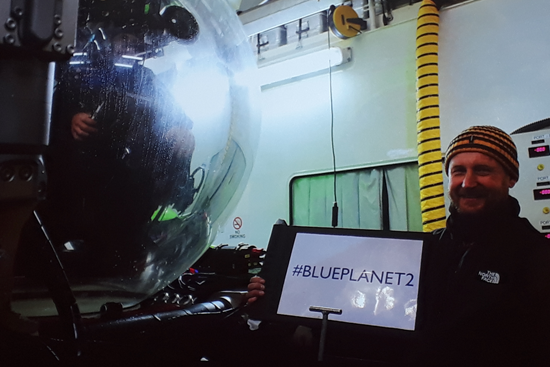
Jon talked about the first dives by human-occupied vehicles to 1km deep in the Antarctic Ocean and the excitement of seeing deep sea life in situ. Some of the weird and wonderful animals that inhabit these waters that are adapted to cope with almost freezing temperatures and the much greater pressures found at depth.
He showed photos of some of species which did not make the final cuts of the film series; this included the 'ice dragon' fish that lacks haemoglobin and enormous sea spiders with 40 cm leg-spans.
The ecosystem structure of the Antarctic deep sea resembles those of the oceans across the globe before fish dominated as predators over 350 million years ago and Jon discussed the way in which ancestors of some deep sea animals spread out from the Antarctic following the flow of oxygen-rich waters. Changes in global climate patterns are likely to change many of the processes helping to maintain these ecosystems.
Jon also compared his experience of working with a well-equipped film crew with conducting research funded by grants.
After speaking with real enthusiasm and authority, Jon took a huge number of questions from the audience afterwards, which reflected the level of interest generated by this most interesting and stimulating of lectures.
Dr Hilary Otter FRSB
Brilliant Biodiversity lecture series
13 September 2017
Biology Week 2017 offered us the challenging but exciting opportunity to hold not just one but a series of lectures across the region. We chose to focus on biodiversity and to explore some of the ways in which man as a species interacts with disease-causing organisms. Dr Neil Gostling (University of Southampton) launched the week with a lively talk titled, The Cambrian Explosion: A fast burn or slow fuse? He discussed the lead up to the 'Cambrian Explosion' and what the Earth was like over the four billion years prior. Discussion of Cambrian deposits followed, exploring what they tell us about the origins of biodiversity, including the evolutionary dynamics that occured after this blossoming of animal life and radiation of forms.
Later in the week Professor Luke Alphey (Pirbright Institute) took us from ancient history to the present day in his talk on the world's first field studies using GM individuals to suppress wild mosquito populations. These programmes aim to reduce numbers of these vectors of diseases such as malaria and zika.
Following this, Professor Gareth Williams (University of Bristol) told the story of an extinction with a purpose: the global eradication of smallpox and the role of Edward Jenner in the history of vaccination. A fascinating one and much enjoyed by our relatively young audience.
Our final lecture, Antibiotic Resistance in the Food Chain: A One Health Issue – given by Professor La Ragione (University of Surrey) explored one of the most important issues facing food producers in the 21st Century. He spoke about dosing regimens and the development of novel antimicrobials and their alternatives including pre and probiotics. This was a suitable place to leave the issues raised during the week as antimicrobial resistance remains one of the greatest biological challenges that is – as yet – still to be overcome.
Dr Hilary Otter FRSB
The Isle of Wight Zoo
9 September 2017
Our group of about 25 biologists and nature enthusiasts all departed the Southampton Science Park very excited about the day ahead. We were not to be disappointed. A punctual ferry took us over to Cowes, across a shimmering Solent. We arrived at the Isle of Wight Zoo in Sandown and, after a short welcome including refreshments, we were treated to an interesting and informative talk by the Zoo's education and conservation manager.
We were told about the role of the zoo in helping to support threatened species, especially in Madagascar. The fourth largest island in the world, it is one of the poorest and home to some of the rarest and most unusual species on earth.
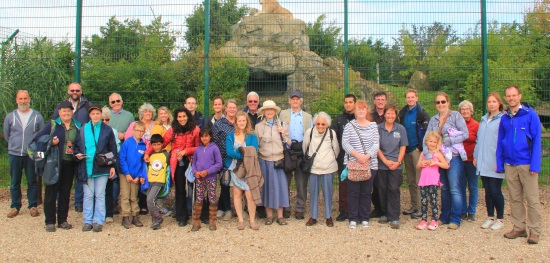
The guided zoo tour introduced us to the variety of animal species which are being supported, including a majestic African lion ("Casper") and his mate "Frosty", Indian tigers, and jaguars, as well as various primate species, lemurs, wallabies, meerkats, and many more humble species such as snakes, lizards, toads and frogs, stick and leaf insects, and a children's pet and play area.
Finally, we were treated to a lecture and laboratory visit introducing the subject of artecology – the combination of art and science aimed at increasing the natural habitat for flora and fauna in our urban structures, by using innovative design and application of building materials.
This is a novel approach and one that seems to hold real promise for enhancing the natural environment for the benefit of plants and other organisms, alongside humans, and is attracting much interest from building corporations and other environmentally concerned organisations.
A great thank you to the staff at the zoo who helped to make the event so worthwhile and enjoyable, and for the Wessex team, especially Martin Taylor, for the excellent organisation.
Richard Vercoe CBiol MRSB
Pheromones: “Success of the Smelliest”
14 September 2016
Tristram Wyatt, senior research associate in the Zoology Department at the University of Oxford, gave our audience an amusing yet thought provoking talk on pheromones.
Tristram’s main areas of interest and research are how pheromones – the molecules used for chemical communication – evolve, and their effect on animal behaviour.
Tristram’s talk was comprehensive and inclusive; from his own research to how corporations “hijacked” the science behind human pheromones for their own financial benefit.
Starting by clarifying the definition of a pheromone, Tristram reminded those gathered that invisible signals had been noted between animals for centuries; for example, the practice of keeping bees originating in the 17th century. Darwin also hypothesised that successful animals are the smelliest.
Tristram continued apace, highlighting when pheromones were first identified, explaining how pheromones are used by animal species, and not just for sex! Pheromones may cause a physiological or behavioural response, which proves directly consequential to both natural and sexual evolution.
Our audience was broad, with members, guests, professionals and students alike. Held at the Discovery Centre, Winchester, the event was ideally located. Those able to attend created an insightful yet personal group whose questioning took the event beyond our schedule. Tristram was bemused by the calibre of questions posed, mainly from students.
The subject matter was broad and participants had a chance to find out about the breadth of applications that biology provides within academia or industry. Furthermore, this was a rare opportunity for local students to speak with a professional biologist in person – all while consuming caffeine and cake.
Thanks to Tristram for an informative talk, one that will undoubtedly be remembered well.
Mr Martin C Taylor MRSB
British Biology Olympiad Award Evening
3 March 2016
Ask most sixth form biology students about the range of jobs and activities open to biologists and they are likely to come up with a very short and predictable list of possibilities, including all forms of medical science, biochemistry and possibly environmental science. So an event at which students from a range of local schools and colleges are able to meet and talk to enthusiastic and knowledgeable professionals is hugely valuable and can help a student contemplating the next stage of their education to have a much greater understanding of the breadth of this subject in the 21st century.
Thus the Wessex celebration of British Biology Olympiad medallists began with the opportunity to ‘meet the biologists’ and, as in previous years, a straw poll after the event made it clear how much everyone (volunteers and students alike!) had enjoyed this and how much enthusiasm and interest it had generated.
Following this with a highly interactive and entertaining lecture titled ‘Dying to be beautiful’ from Dr Kathryn Harkup added further to the informative nature of the evening. The number of questions asked was a sure sign of engagement from the audience.
Dr Hilary Otter FRSB
Lower Sixth Careers Convention
March 2016
Dr Elizabeth Evesham and Dr Marja Aberson of the RSB were invited for the second year running to present at the annual Careers Convention at Sherborne School to talk through their individual careers in biology.
Dr Evesham provided the sixth form pupils with an engaging insight into her research and educational route into biology, and Dr Aberson presented her experience of a career in the private sector.
The fair also had guest speakers representing multiple disciplines, including the arts, armed forces, finance and other sciences. The fair was a success all around and with much positive feedback from the pupils regarding the biological talks, including: “I was not really considering this, but I will now.”
This had been another great opportunity to educate students on the diversity of options available in biological sciences and to also promote the Society to such a young and interested audience.
Dr Marja Aberson CBiol MRSB
AGM and Lecture: Ebola Response: Sequencing, Vaccines, and Survivors, Professor Miles Carrol, Public Health England
26 November, 2015
Wessex Branch held its AGM at the Winchester Discovery Centre, Jewry St. Winchester. The Chairman gave a brief review of the year, highlighting the UK Biology Olympiad Wessex regional award ceremony, hosted for the second time in 2015 at St. Swithun’s School in Winchester, and the Science Communication Video event at Southampton University; and the Treasurer gave a report of finances. The committee was re-elected, and welcomed a new member, Noelle Joby, to their number.
Following the business meeting, the attendees were rewarded with a lecture on the support given by Public Health England to the World Health Organization mobile laboratories during the Ebola outbreak in West Africa in 2014. The lecture was given by Professor Miles Carroll, Research Director at Public Health England, who co-ordinated the UK support to the mobile laboratories.
Professor Carroll illuminated the sophistication of techniques and equipment that were successfully deployed to provide diagnostic tests and epidemiological data to combat the outbreak in low income settings. He gave a vivid description of how the partnership of the willing was able to map the outbreak in real time and provide vital information to the World Health Organization on how the virus was interacting with patients and populations, and whether or not it was mutating as it did so. He described an energetic and committed UK contribution to an international effort, that forged links with medical scientists in the affected region that will continue long after the outbreak is definitively over, and contribute to preparedness for other outbreaks that may occur.
Dr David Ulaeto, FSB
Conservation Walk on Porton Down
7 June 2015
This 2,750 hectare woodland and chalk downland estate was acquired in 1916 by the War Department (now the MoD / Defence Science and Technology Laboratory) for a high-security research unit.
About 1,591 ha of this is designated a Site of Special Scientific Interest (SSSI) due to its very high species richness; a Special Protection Area (SPA) for stone-curlews; a Special Area of Conservation (SAC) for its chalk grassland and as a monitoring site for the Environmental Change Network.
Some 20 Society members were led by Sarah Atkinson from the site's conservation team. The area has many orchids and in the woodland we saw spotted, birdsnest and lady orchids, and a range of other plants including ladies slipper and white helleborines. As many as 44 species of butterfly have been recorded at Porton (78% of the British list) and there were green hairstreaks and blues in every sunny glade – part of the conservation work – but sadly the only evidence of the declining duke of burgundy was a detached wing in a funnel spider's web.
The downland offered wide views across Salisbury Plain and we were told of the efforts to regenerate the declining juniper scrub and other problems with rabbits. The site has 10% of the UK nesting population of the migratory stone-curlew that depend on rabbits to expose chalky, stony ground for nest 'scrapes' and also to keep the surrounding downland tightly grazed so that they can find insects, earthworms and beetles. However, the rabbits support a high population of foxes that also eat the chicks.
There was so much to look at and appreciate that our progress was slow. On the way back we had an excellent view of a male peregrine perched above its nest site on the top of a tall concrete tower. Apparently the tower is a "hard target" and subject to regular explosions. The birds are undeterred by this and simply fly up and away for a short time before returning to the nest.
This was a hugely enjoyable day. We would all like to convey our sincere thanks to all the people at DSTL Porton, and on the Wessex branch committee, who made it such an interesting and informative visit.
Pam Speed CBiol MRSB, West Midlands branch
Olympiad awards evening & careers event
19 March 2015
Sixth form biology students from across the Winchester area gathered at St Swithun's School for a busy and varied evening to celebrate the achievements of those who had won awards in the 2015 British Biology Olympiad. Twenty professional biologists, many of whom were members of the Society, generously gave up their time to come and talk to students about their work and backgrounds.
Coffee and cake broke the ice before the event began with a 'meet the biologist' speed dating activity. This proved a hugely successful format and the noise in the hall was evidence of how much students enjoyed meeting 'real' biologists whose jobs included virus hunting, parasitology, medicine, nursing, vet medicine, science writing, molecular genetics, forestry and deep sea biology amongst others. Feedback from students after the event included the comment from one student that she 'had no idea that forestry was so scientific and that it offered such an interesting and progressive career path'.
This was followed by a hugely enjoyable lecture on 'Poisons – murder from a molecular point of view' given by science communicator, Dr Kathryn Harkup. She focused on four poisons in particular and examined the effects they have on the physiology and biochemistry of the body. The talk was perfectly pitched for thoughtful and interested student biologists and this, combined with Kathryn's engaging style, provoked a large number of questions from the students.
During the final part of the evening, Wessex awards and book prizes were presented to Olympiad award winners, after which more coffee and cake was consumed as some students continued to discuss the relative 'merits' of various poisons whilst others continued their conversations with the 'professionals' more informally.
Dr Hilary Otter FSB
AGM and Lungs Lecture
12 November 2014
As prospective medics, we were intrigued by Dr Karl J Staples lecture on how the lungs defend themselves from infection, held at the Science Learning Centre at the University of Southampton.
Staples is senior research fellow at the university, and began his talk with an introduction to the innate defences in the lungs – such as the macrophages that eliminate pathogens by releasing reactive nitrogen and oxygen, which act like bleach. It was interesting to know that the formation of surfactant is triggered by a baby's first breath. This fluid is a combination of phospholipids which bind to pathogens and serve as markers for macrophages.
To everyone's surprise, the lungs actually also contain beneficial bacteria. Also, we learnt about researching respiratory diseases, for example the different methods of collecting data for analysis, including endobronchial biopsy and nasal lavage.
As sixth form students, this was an excellent opportunity to expand our scientific knowledge beyond our A level course. Staples explained the content in a concise manner which made it easy for us to understand. In summary: breathtaking!
Elisa Chen Yao and Genevieve Chan
St Swithun's School and Bionet Members
Brownsea Island
6 September 2014
Our Brownsea Island field trip was so popular that we had to turn away late applicants. In fine autumn weather, many members took early ferries and spent the morning exploring the island.
We assembled after lunch and were introduced to our guides - the National Trust's property manager Angela Cott and warden John Lamming.
Half the group set off with Angela as she gave an overview of the environmental and social-economic management challenges faced by the trust. The charity has worked hard to balance the conservation needs of the island while enhancing the public's experience and now sees 120,000 visitors each year. Climate change may also threaten the island's coastal habitats in the future.
The highest point on the island offers stunning views across Poole Harbour to the Purbecks. At this point we swapped leaders and John described the wildlife and habitats on the island, specifically, the ecology of the squirrels which obligingly scrambled up and down the trees around us as he spoke. Red squirrels have a mixed diet but their favourite is Scots pine seeds or 'pine nuts' which are tediously extracted by biting the scales off pine cones. A squirrel requires 550 kJ a day, but a pine seed provides only 0.18 kJ, and the 200 squirrels on the island can demand up to 219 million seeds a year. Unfortunately the trees are ageing and are producing fewer cones, with little sign of regeneration – mainly because of uncontrolled Rhododendron.
Dr Marja Aberson CBiol MSB
Olympiad Awards Ceremony
27 March 2014
Professor Mike Tipton, of the Department of Exercise and Sports Science at Portsmouth University, captivated and challenged his audience in his lecture to British Biology Olympiad 2014 medallists and 6th form biology students from across Hampshire. They had gathered along with parents, teachers, members and guests to form a small but hugely enthusiastic audience at St Swithun's School, Winchester. Dr Mark Downs, chief executive of the Society, awarded certificates to students in celebration of their achievements.
Professor Tipton works in the Extreme Environments Laboratory, which examines the physiological and psychological responses of the human body to adverse environments. He also advises on the selection, preparation and protection of those who enter such environments.
Homeostasis is an important topic in A level biology and Professor Tipton wove some compelling examples into his clear explanations. He explained the physiology behind the advice given to the British cycling team about the best methods to cool down between warm up and events at the Beijing Olympics in order to avoid central fatigue. This resulted in the ingenious use of cheap camp chairs and plastic bags full of cold water.
This event also gave students an excellent opportunity to quiz the professional biologists on the Wessex committee over coffee and cake; discussions ranged widely and provided more opportunities to gain an understanding of the breadth of applications of biology in the workplace.
Hilary Otter CBiol FSB
Pirbright Lecture
20 November 2013
Professor John Fazakerley director of the Pirbright Institute (formerly the Institute for Animal Health) since 2011 delivered a popular lecture entitled 'The New Pirbright Institute'. He is overseeing the redevelopment of the Institute's main site at Pirbright in Surrey, with development funds from the Biotechnology and Biological Sciences Research Council (BBSRC) and the Department of Business, Innovation and Skills (BIS).
The lecture was wide ranging, covering the science research programme of the Institute, Professor Fazakerley's own research on alphaviruses, the history of the Institute, and the state-of-the-art new facilities being built to house some of the most dangerous human and livestock disease viruses in the world.
Our 33 strong audience included research scientists and science professionals, teachers, sixth form students, retired members, and others; and the lecture had something for all. Professor Fazakerley spoke for 45 minutes and then spent another 30 minutes answering questions from all corners of the room. With the lecture held at Winchester's Holiday Inn Conference Centre, a number of members retired to the bar after the lecture, where Professor Fazakerley joined us to continue the discussions.
Many thanks to Professor Fazakerley for an excellent talk and for making a great event for our members.
David Ulaeto CBiol FSB
Our Great British Marine Life
14 November 2013
British Wildlife Photographer of the Year 2012 Dr Matthew Doggett gave an entertaining and knowledgeable talk after our AGM. His talk was supplemented by photographs from his trips around the British Isles (as well as a few from his wife, Polly Whyte). These amazing photos encapsulated life beneath our waves!
Approximately 30 members and non-members began their tour of the British Isles on the South Coast in Poole. We were treated to numerous photographs of various fish species such as the goldsinny wrasse (Ctenolabrus rupestris), Baillon's wrasse (Symphodus bailloni) as well as more unusual species such as topknot (Zeugopterus punctatus) and conger eel (Conger conger). The tour continued to Lyme Bay where the tompot blenny (Parablennius gattorugine), snakelocks anemone shrimp (Periclimenes sagittifer) and the Leopard-spotted goby (Thorogobius ephippiatus) were the name of the game.
In Scotland and their Islands, we were treated to some amazing photographs of nudibranchs and corals as well as video footage from a lagoon where quite literally a "sea" of moon jelly fish (Aurelia aurelia) can be found. Other fantastic creatures included the mauve jellyfish (Pelagia noctiluca) at Sula Sgeir, Scotland and the red scorpion fish (Scorpaena scrofa) in St Abbs, Scotland.
Our tour ended in Shetland with some fascinating video that encapsulated the gannets' amazing ability to fish. The detail and "luck" of one particular shot of these amazing animals secured Matt the title of British Wildlife Photographer of the Year 2012!
Matt continues to explore life beneath the waves and together with his colleagues from Earth in Focus promotes wildlife of the British Isles and abroad through photography.
Karen Anderson CBiol MSB
Science day for year 10 girls
3 October 2013
Ambassadors from the Society were involved in a science careers event at South Wilts Grammar School for Girls, Salisbury. The collapsed timetable day was created for the 130 Year 10 students and aimed at getting them to think about how the sciences can be applied beyond GCSE and A level. Part of the day involved a speed dating style session in which small groups of students spent 5 minutes grilling a professional scientist before moving on to the next one. Many of the scientists involved in this activity volunteered through the Society of Biology and ranged from academics and consultants to test pilots and authors.
Other activities included a planetarium show, chemistry demonstrations involving liquid nitrogen, talks from local companies, DSTL, PHE and Harnham Water Meadows Trust. Student teams also competed in an Engineering Challenge to build towers from spaghetti. This is an annual event hosted by the school which always relies on the generous support of local volunteers in giving up their time for the girls.
Jane Brown
A forest through time
14 September 2013
The New Forest is an area of outstanding natural beauty which has been of scientific interest for 40 years, and in 2005 was designated as a National Park. Gillie Hayball, a New Forest park ranger headed an engaging walk introducing its history, management and conservation.
The walk began upon the Yew capped Bolton's Bench, an ancient burial mound which offered beautiful views of Lyndhurst and the surrounding forest.
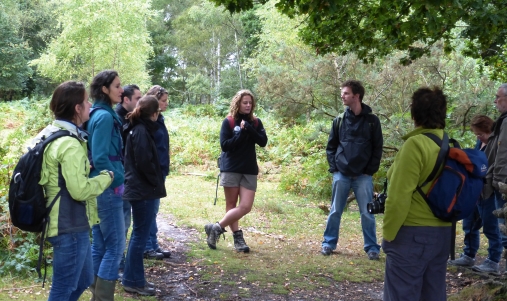
The group was lucky to also have the experience of Barry Dowsett; an appointed Forestry Commission Verderer. 'Verderer' comes from the French word 'vert' which means green. The New Forest Verderers date back to the 13th century, they regulate the rights of the commoners and set forest byelaws. One of the main rights of the commoners is the ability to turn their animals out to 'pasture'. The diversity in grazing activity has helped shape the landscape of the forest over time.
After walking across the open heathland, the group learnt about the deer population of the forest and of the management of the four main populations present: Fallow (Dama dama), Roe (Capreolus capreolus), Red (Cervus elaphus) and Sika (Cervus Nippon).
We ended with a challenge: how do you age a tree? One easy way is to 'hug for a 100' - if one person can hug a tree it will indicate 100 years of growth. An interactive map is being developed from a database of ancient and unusual trees in the UK, The Ancient Tree Hunt.
Dr Marja Aberson MSB
Fossil Foray
9 June 2013
Charmouth local expert Chris Pamplin introduced us to the Jurassic Coast, a 95 mile long World Heritage Site. The cliffs and foreshore here mainly represent two stages within the Lias (Early Jurassic), dating from approximately 190 million years ago. At this time the continents had not separated and this area was closer to the equator, roughly where North Africa is today. Moreover it was submerged by a large sea, less than 100m deep, in which alternating layers of clay and limestone were laid down. These Jurassic sediments were then overlain by younger (100 million years ago) Cretaceous deposits. Subsequent erosion removed all the more recent deposits and, at Charmouth, most of the Cretaceous as well. Life was abundant during the Jurassic but as this area was far from any significant landmass most of the fossils are marine - ammonites, nautili, belemnites, crinoids, bivalves, fish and bones of marine reptiles.
Chris had brought along many representative specimens and gave us tips on finding fossils on the foreshore. Fossil bones, mainly vertebrae, are black as are pyritised ammonites; both are to be found lying in sandy areas as the tide falls. We were shown how to recognise, and split, likely rocks. Then we were let loose with our hammers and goggles, with warnings not to get too close to the cliffs.
There was a steady stream of finds including a palm-sized ammonite split from a rock. We made our way back to the visitor centre (and fossil shop) where we thanked Chris for his entertaining and informative introduction to fossils (and for laying on good weather).
Jack Coughlan CBiol MSB
Sandown Zoo
15 September 2012
Members went to sea again last September, although this time we were after bigger game than plankton. Our destination was Sandown Zoo on the Isle of Wight where one of our members, Tracy Dove, the education and conservation officer, had kindly offered to host our visit. Wessex has a dozen or so members on the Island but this was the first time in the branch's 40+ years that we have organised an event there.
Tracy outlined the zoo's history, ethos and activities that ranged from breeding programmes and international field conservation projects through to public education. We then had a guided tour of part of the animal collection. The zoo's vet discussed the welfare aspects and explained how large cats could be trained, a sort of Pavlovian conditioning, to accept routine non-invasive veterinary monitoring and treatment without resort to anaesthetics. Similarly, emphasis was placed on retaining patterns of behaviour that maintained activity and fitness. The tigers had to jump into a large pool in their enclosure and drag ashore chunks of horsemeat tied to wooden rafts. Surprisingly the tigers and jaguars did not come from the wild or from other zoos, but had been rescued from garages and backyards in the UK.
Most people are familiar with conservation projects undertaken by zoos such as Whipsnade and Marwell but are unaware of the work of 'small' zoos (fewer than 100,000 visitors annually) such as Sandown. We all came away with extremely favourable impressions, not just of Sandown Zoo itself, but also of its contributions to education and overseas conservation projects. Moreover the lunch was greatly appreciated but we were glad we didn't have to jump into the tiger pond to get it.
Jack Coughlan CBiol MSB



